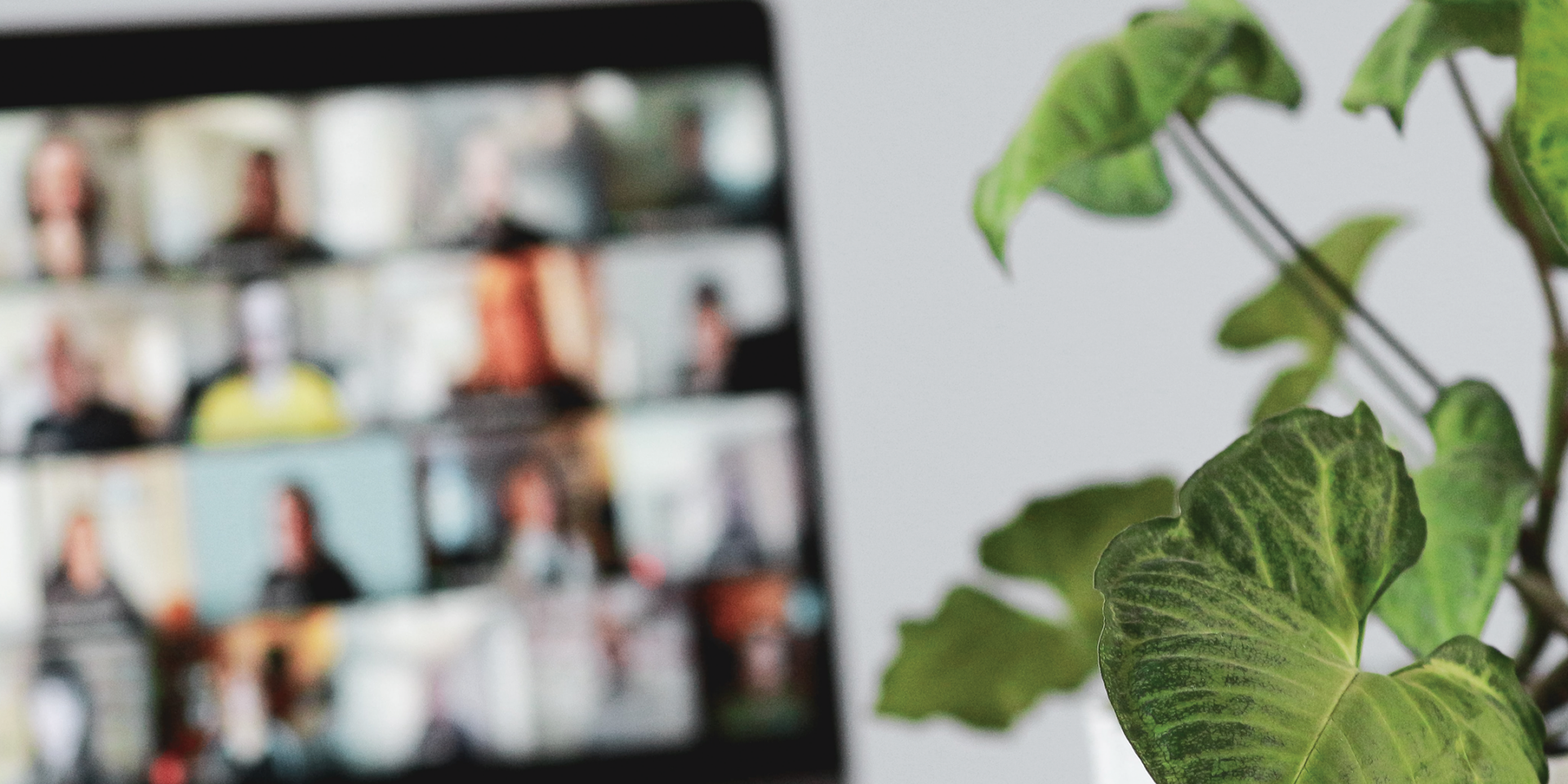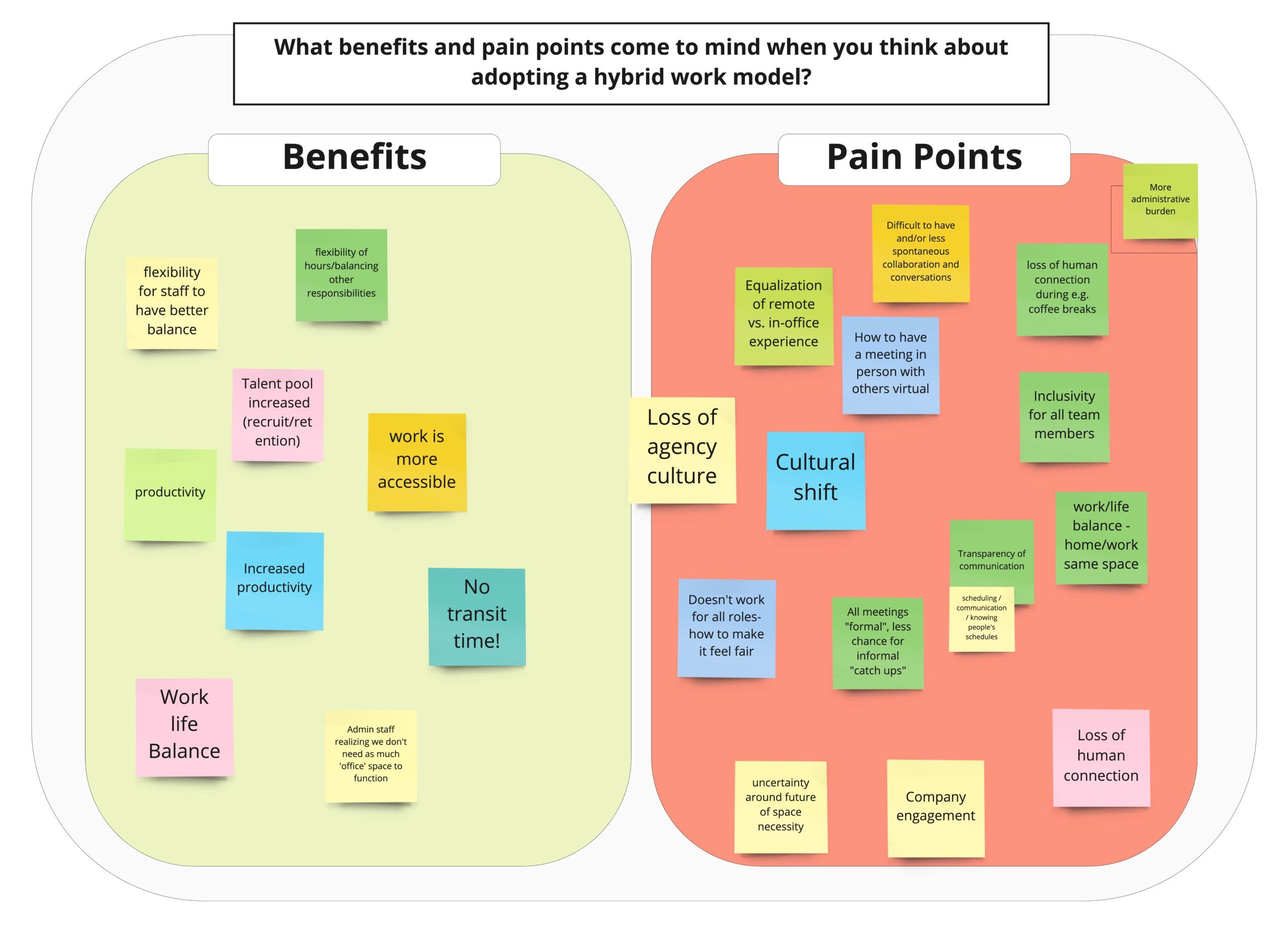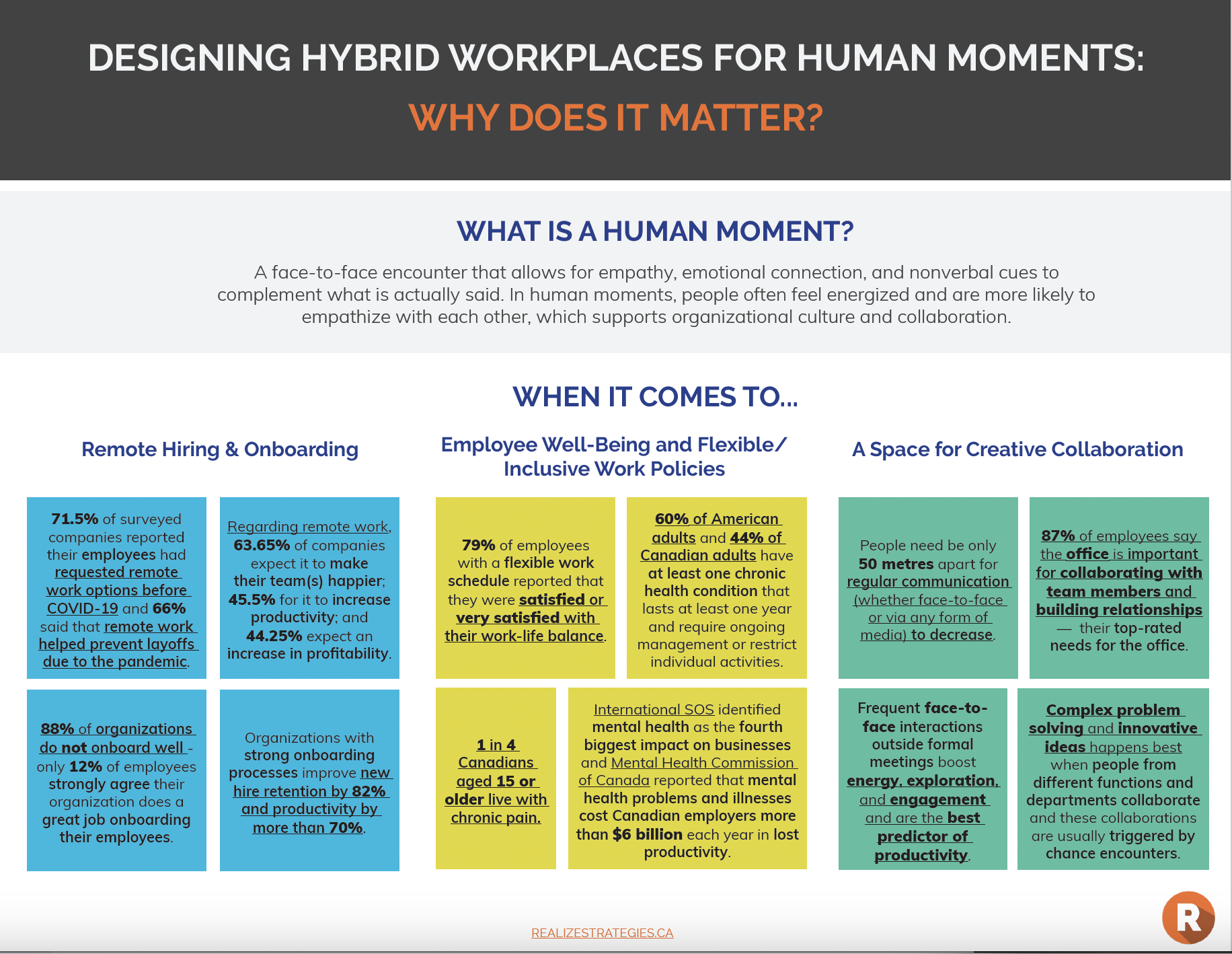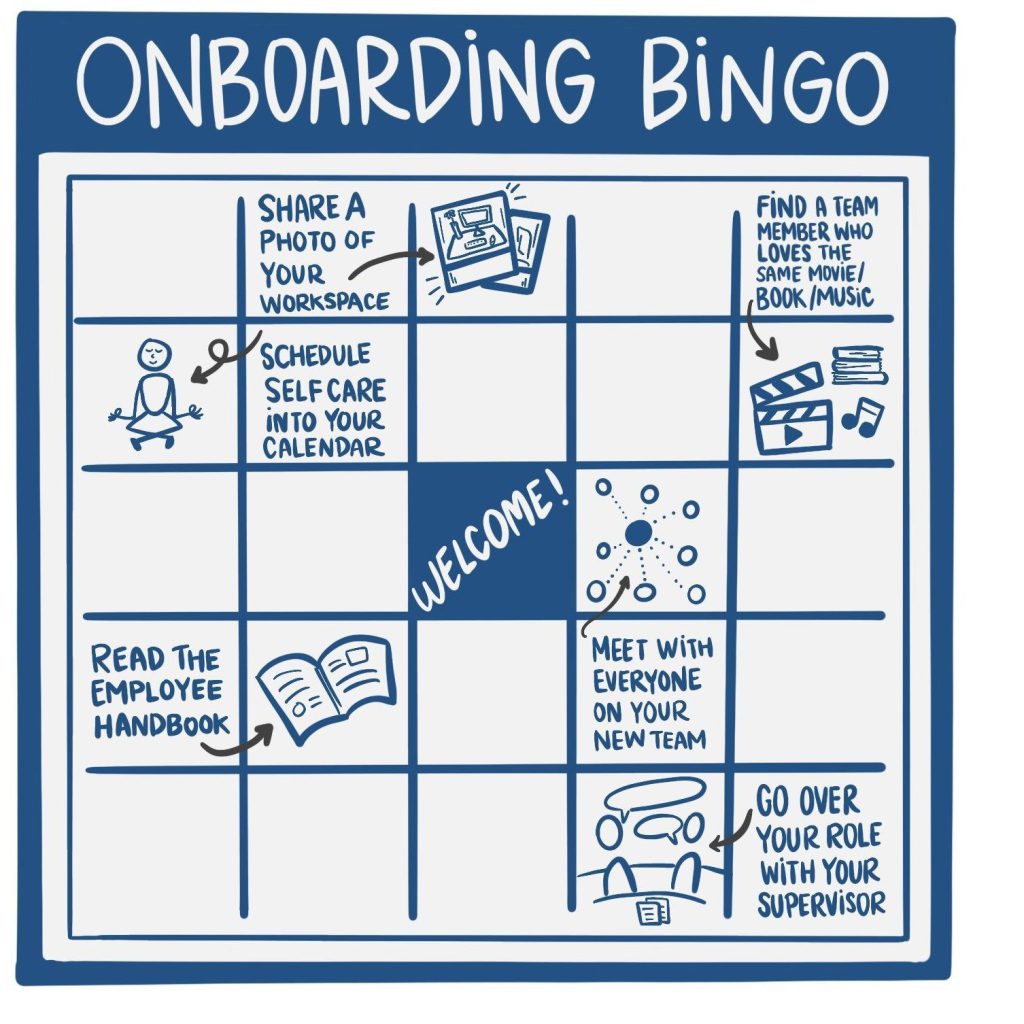Designing Hybrid Workplaces for Human Moments
Published on June 15, 2021
How might we design a new hybrid workspace that fosters collaborative, innovative, and spontaneous “human moments”?
This was the topic we dove into at our “Design Hybrid Workplaces for Human Moments” workshop we led with passionate leaders and change makers from multiple sectors and across Canada and the U.S. Together we ideated solutions and shared experiences and hurdles regarding:
- Remote hiring and onboarding;
- Supporting employee well-being through inclusive/flexible workplace policies; and
- Reimagining your office as a cultural touchpoint.
“No one knows everything. But together, we know a whole lot.”
– Simon Sinek
What is a human moment?
A “human moment” refers to a face-to-face encounter that allows for empathy, emotional connection, and nonverbal cues to complement what is actually said. In human moments, people often feel energized and are more likely to empathize with each other, which supports organizational culture and collaboration.
Identifying current benefits and pain points
We started our session asking everyone what were some of the benefits and pain points that came to mind when it came to adopting a hybrid work model. A common and major benefit of allowing remote work (full or part-time) was that it drastically reduced transit times as well as allowing staff the flexibility to work whenever/wherever it was most productive for them as well having a better work/life balance. On the flip side, pain points included the loss of human connection, losing team culture or having it weaken without in-person connections, feeling overwhelmed by formal work meetings, and how to create an equitable work experience for all staff (especially when not all roles are compatible with remote work).

Key stats: Why does it matter?
During Real Talk we shared some insights on why this topic of designing hybrid workplaces for human moments is so important. Click here to view and download the full interactive roundup of insights and statistics! Here are a few key stats to keep in mind:
Remote hiring and onboarding
- Regarding remote work, 63.65% of companies expect remote work to make their team(s) happier; 45.5% expect remote work to increase productivity; 44.25% expect remote work to increase profitability.
- Organizations with strong onboarding processes improve new hire retention by 82% and productivity by more than 70%.
Employee well-being and flexible/inclusive work policies
- 60% of American adults and 44% of Canadian adults have at least one chronic health condition that last at least one year and require ongoing management or restrict an individual’s activities. 1 in 4 Canadians aged 15 or older live with chronic pain.
- International SOS identified mental health as the fourth biggest impact on businesses in the coming year and Mental Health Commission of Canada reported that mental health problems and illnesses cost Canadian employers more than $6 billion each year in lost productivity from absenteeism, presenteeism, and turnover.
A space for creative collaboration
- 87% of employees say the office is important for collaborating with team members and building relationships – their top-rated needs for the office.
- Frequent face-to-face interactions outside formal meetings boost energy, exploration and engagement and are the best predictor of productivity. Complex problem solving and innovative ideas happens best when people from different functions and departments collaborate and these collaborations are usually triggered by chance encounters.

Sharing experiences and co-creating solutions
Working in small groups of 3-5, leaders tackled barriers and solutions to designing hybrid workspaces for human moments. The amount of collaboration, innovation, and passion that came from everyone was amazing! Here are some of the highlights:
Remote hiring and onboarding
Focus your virtual interviews on the capabilities necessary for the role, not on how a candidate use the technology for this interview.
During the hiring process in a virtual setting, bias can creep in unexpectedly as we pick up on a candidate’s level of technological skill and comfort, even when it has no relevancy to their work capabilities. For example, a candidate’s interview doesn’t go as well as it could due to their lack of familiarity of using Zoom and loses points, even though their role would not involve the use of Zoom at all. During Real Talk, it was suggested to hold your initial interview over the phone if you can’t hold it in person. This can level the playing field for candidates at the start. Then, after confirming with HR, consider allowing candidates the freedom to choose what medium they are most comfortable with when presenting their work – maybe it’s a PowerPoint, a video presentation, a written summary, or something else! Stay true to the technology and demonstration of skills in an interview that will be relevant to the role.

Engage your entire team when bringing on new staff with Onboarding Bingo
While working remotely, people are often missing that in-person connection. For new hires in particular, it can be hard to build trust and camaraderie with their new team while working remote and not being together in an office where one can read body language cues, easily start casual conversation, feel comfortable asking others questions, etc. That’s why Gillian Harper, our Organizational Development Consultant developed Onboarding Bingo as a fun way for new and existing members to meet and get to know one another in a casual setting rather than a formal (and potentially daunting) meeting. Here are some questions you can use to engage your whole team (new and longstanding members) and inspire your own version of Onboarding Bingo:
- Share a photo of your workspace with the team
- Read our Employee Handbook and note down any questions you may have
- Meet with every person from your new team (one-on-one or small groups)
- Schedule self-care into your calendar (walk, stretch, yoga, meditation, etc.)
- Find someone on your team who loves the same TV show / movie / book as you do
- Review your job description / role with your supervisor
Employee well-being and flexible/inclusive work policies
Creating flexible vacation policies to better address employee wellness and/or burnout
Travel restrictions stemming from the pandemic have meant that very few people feel like they can, or want to, take a vacation. However, working continuously without a break doesn’t just impact your employees’ mental health (i.e., burnout, stress, anxiety), it’s also a financial risk for your organization. That’s why some of folks from Stocksy shared at Real Talk that they have implemented a new unlimited vacation policy for higher-level employees and are seeing a positive change. At Realize, we’ve decided to tackle to same problem by closing down our office for a week this summer so our staff can enjoy the sunshine and relax without worrying about continuing operations – check out our article to learn more about how and why we’re doing our summer office closure.
How formal do your meetings need to be?
When it comes to meetings, most of us are used to gathering together in a boardroom (when in-person) or settling in front of computers for a virtual Zoom meeting. But does your meeting actually require everyone to be sitting down together? While keeping tactical meetings with heavy agendas as sit down meetings may make the most sense, relationship building meetings such as check-ins are more casual. It was suggested at Real Talk that these casual meetings can be held over phone and participants are encouraged to get out and take a walk to enjoy some fresh air. Many participants also shared that video meetings can often feel more draining than in-person meetings due to a lack of space for casual chats/catch-ups so creating space for casual non work-focused gatherings to bring back those casual conversations and connections (ex. virtual Thirsty Thursdays) is important.
A space for creative collaboration
Adapt your office space to be used for creativity and focus
As research shows, 87% of employees say the office is important for collaborating with team members and building relationships – their top-rated needs for the office. Establishing and maintaining space for casual conversation encourages innovative collaboration as well as helping to boost team culture. Having a kitchen/lunch area, comfy chairs, an area to post and share interesting research, open space for brainstorming, and more were suggested as valuable ways to engage staff.
Determine when being in-person is necessary
When asked when in-person meetings might be necessary, some mentioned the difference between tactical meetings that are heavy on the agenda side, and relationship building meetings. Tactical meetings are more efficient online than in person, but when dealing with conflict, having face-to-face conversations are beneficial. With your team, determine what kinds of discussions need to be done in person.
Don’t assume – do your own research
When considering changes to your office space, policies, or other items, don’t just assume you know your employees’ needs/wants/pain points; ask them directly. Engage your employees in the process and get better buy-in when you empower your employees to share their honest thoughts and concerns and be co-creators in organizational changes. Townhalls or anonymous employee surveys are great ways to engage your teams and create space for an open dialogue. This allows us to make big decisions with confidence because we know what truly matters the most to your people, what changes are happening, and why.
Contributors




